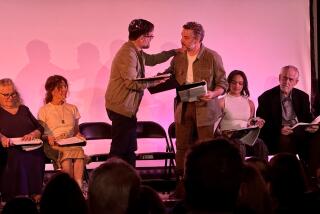Turning Tragedy Into Art, and Art Into Understanding
- Share via
A bloodied Jewish star sags alone in a brown-gold field. A ghetto, eerie and empty, tilts under a cloudy sky. The Ten Commandments crumble. A holy book burns. A prayer shawl lies in the dirt, twisted and abandoned.
Haunting, horrifying images. But in them, teachers found hope.
These teachers had come from across Los Angeles to study the paintings in an elegant temple gallery. For more than two hours Thursday night, they discussed the searing canvases with the artist, Holocaust survivor Sam Bak.
They picked apart the symbols and commented on the colors. Most of all, however, they thought about the meaning.
And tried to figure out how they could use Bak’s art to teach their students about racism and hatred, loneliness and murder.
“It’s always painful to me that the need [to teach such subjects] is there,” said Bernard Pucker, a Boston gallery owner who put the show together. “But at least you’re addressing it in an honest and meaningful way.”
Pucker then added a warning: Bak’s art will not yield to simplistic analysis. Teachers must be prepared to explore the issues these canvases raise. “They lead you and your students from one question to another,” Pucker said. “Not one answer to another.”
Although Bak’s paintings burst with symbols of Jewish life, from the six-pointed Star of David to the Hebrew letters for the Almighty, the teachers agreed that all students could draw meaning from them.
“They speak to the human heart--not the Jewish heart, the human heart,” Taft High School teacher Jan Stewart said.
Gazing at the art, teachers knew their students would relate.
Some of the students had been judged lazy or stupid because of their looks. Others had fled from countries convulsed by war.
They could draw on their own experiences to understand Bak’s images: the boat made of brick, mocking thoughts of escape; the key twisting through clouds, searching for answers. By making the link between the long-ago Holocaust and modern-day racism, the students might come to understand that hatred endures. And they might vow together to combat it.
“Awful things happen, but you have to go on--and make sure those terrible things don’t happen to others,” Los Angeles High School history teacher Tamara Hoffman said.
One of Bak’s towering canvases captures a soldier slumped over his rifle, prayer shawl on his lap. Shattered stone tablets litter the ground--the remnants of the Ten Commandments, split into gravestones. One fragment bears the number 6, an allusion to both the 6 million Jews slain in the Holocaust and the desecrated 6th Commandment, “Thou shalt not kill.”
Like most of Bak’s work, this painting offers teachers a rich subject for discussion.
For one, it’s beautiful, despite the grim subject.
“My students have come from very distressing situations,” said Judy Patel, who teaches English as a second language at Eagle Rock High School. “It’s hopeful for them to see that so much creativity could come out of someone who has suffered so much,”
Just as important, the painting poses questions about war and death, evil and religion.
*
The 30 teachers who attended Bak’s workshop at the Wilshire Boulevard Temple have already begun to explore these subjects in their classrooms, using a curriculum developed by the educational organization Facing History and Ourselves.
Facing History has trained scores of teachers in Los Angeles--and thousands nationwide--to introduce students to the ethical and emotional issues swirling around the Holocaust. Teachers are encouraged to move beyond World War II and trace the history of racism and hatred through the Los Angeles riots and the Bosnian war. They also ask students to probe their own prejudices, to think about the psychology of the oppressors as well as the trauma of the victims.
The Facing History curriculum draws on movies, literature and historical documents. Now, teachers will be able to add art.
“It’s one more way to look at the Holocaust,” Taft High teacher Richard Gibbons said. “And it’s so powerful.”
*
Bak’s art does not revisit the familiar Holocaust images of starving inmates and barbed-wire fences.
But he does paint memorial candles trailing smoke, ominously echoing the Nazi crematoriums. On another canvas, he squeezes a jumble of houses into a boxcar, a reference to the mass deportation of Jewish villagers.
“It’s especially good for young people whose minds are not yet fixed into the straitjackets of stereotypes,” Bak said. “With the help of good teachers, they can develop an understanding that life . . . [includes] all kinds of tragic things, yet there is an incredible force that drives man toward hope.”
Bak has felt that force since 1942--when, at the age of 9, he attended an art show in the cramped ghetto where Polish Jews were forced to live. He marveled even then, he said, that people could create art in such degrading conditions.
Somehow, Bak sustained that sense of wonder throughout the Holocaust.
He felt lucky to be alive: only 200 of the 80,000 Jews from his Polish hometown of Vilna survived the war.
Now living in Weston, Mass., Bak says he feels driven to capture the Holocaust in paint--not just for Jews, but for everybody.
“I am speaking of a world that was shattered, of the process of growing up and rebuilding,” Bak said. “Which, when you think about it, is everyone’s experience.”
Bak’s work will be display ed at the Wilshire Boulevard Temple through Jan. 1. The gallery, at 3663 Wilshire Blvd . , is open Monday through Friday from 10 a.m. to 4 p.m., and Sunday from 10 a.m. to 1 p.m. For information, call Rabbi Steven Leder at (213) 388-2401. For information on Facing History and Ourselves, call Dan Alba at (818) 798-9221.
More to Read
The biggest entertainment stories
Get our big stories about Hollywood, film, television, music, arts, culture and more right in your inbox as soon as they publish.
You may occasionally receive promotional content from the Los Angeles Times.










